 The Autumn Statement was announced by Jeremy Hunt in Parliament on Thursday 17th November. This was Hunt’s first big speech since becoming Chancellor or the Exchequer a few weeks ago. He revealed to the House of Commons that there will be tax rises and spending cuts worth billions of pounds, aimed at mending the nation’s finances. It is hoped that the new plans will restore market confidence shaken by his predecessor’s mini-Budget. He claimed that the mixture of tax rises and spending cuts would be distributed fairly.
The Autumn Statement was announced by Jeremy Hunt in Parliament on Thursday 17th November. This was Hunt’s first big speech since becoming Chancellor or the Exchequer a few weeks ago. He revealed to the House of Commons that there will be tax rises and spending cuts worth billions of pounds, aimed at mending the nation’s finances. It is hoped that the new plans will restore market confidence shaken by his predecessor’s mini-Budget. He claimed that the mixture of tax rises and spending cuts would be distributed fairly.
What is the Autumn statement?
The March Budget is the government’s main financial plan, where it decides how much money people will be taxed and where that money will be spent. The Autumn Statement is like a second Budget. This is an update half a year later on how things are going. However, that doesn’t mean it is not as important. This year’s Autumn Statement is especially important given the number of changes in government in recent months. The Statement unfortunately comes at a time when the cost of living is rising at its fastest rate for 41 years, meaning that it is going to be a tough winter for many people.
Statement overview
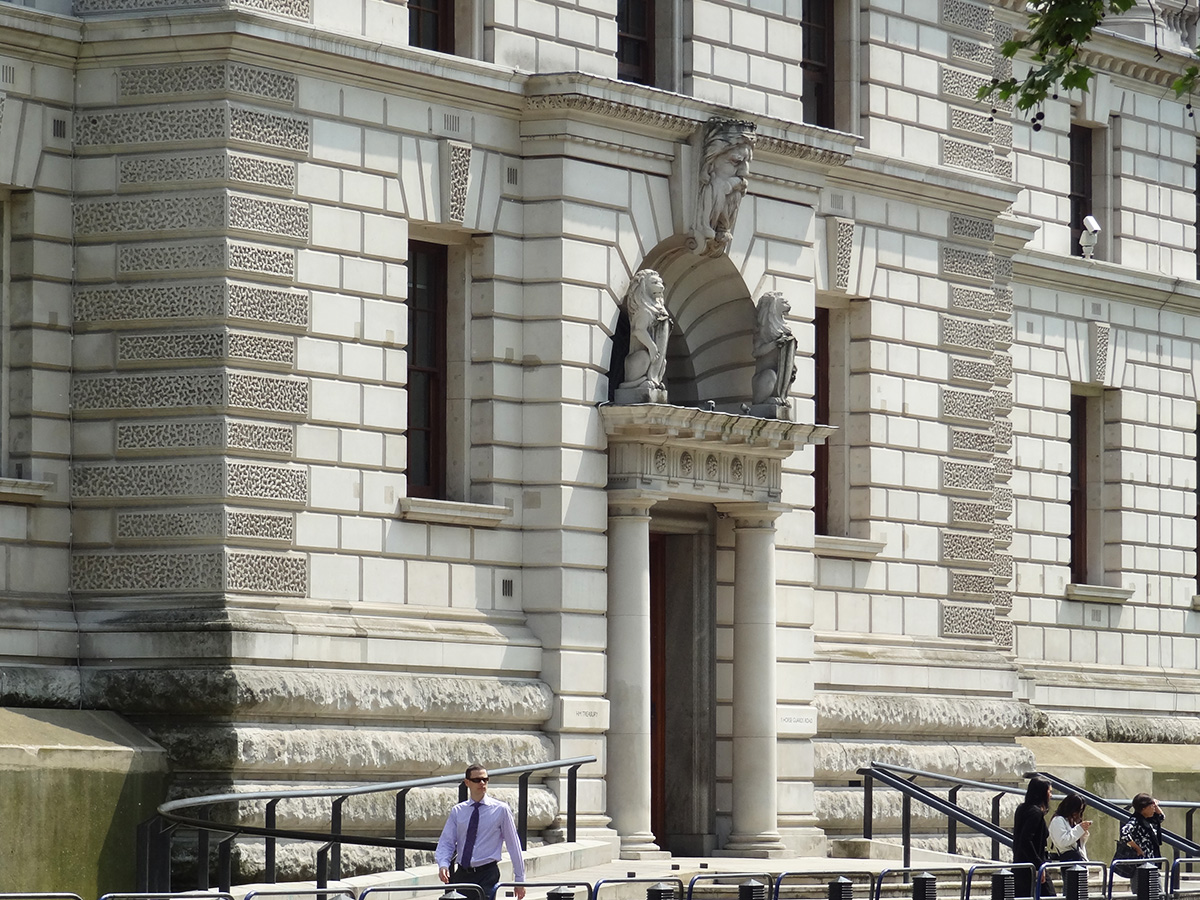 It was expected that the Statement was not going to be one to celebrate, given that the UK is now believed to be in a recession. The Office for Budget Responsibility (OBR) forecasts that the UK economy will shrink by 1.4% next year. However, Hunt said that his focus was on stability and ensuring a shallower downturn. The Chancellor outlined his ‘plan for stability’ by announcing deep spending cuts and tax rises in the autumn statement. He said that half of his £55bn plan would come from tax rises, and the rest from spending cuts.
It was expected that the Statement was not going to be one to celebrate, given that the UK is now believed to be in a recession. The Office for Budget Responsibility (OBR) forecasts that the UK economy will shrink by 1.4% next year. However, Hunt said that his focus was on stability and ensuring a shallower downturn. The Chancellor outlined his ‘plan for stability’ by announcing deep spending cuts and tax rises in the autumn statement. He said that half of his £55bn plan would come from tax rises, and the rest from spending cuts.
The Chancellor plans to tackle rising prices and restore the UK’s credibility with international markets. He said that it will be a balanced path to stability, with the need to tackle inflation to bring down the cost of living while also supporting the economy on a path to sustainable growth. It will mean further concerns for many, but the Chancellor argued that the most vulnerable in society are being protected. He stated that despite difficult decisions being made, the plan was fair.
What was announced?
The government’s overall strategy appears to assume that, by tightening fiscal policy, monetary policy will not have to tighten as much. The hopeful consequence of which is that interest rates will be lower than they otherwise would have been. This means interest-rate sensitive parts of the economy, the housing sector in particular, are more protected than it would have been.
The following are some of the key measures announced:
- Tax thresholds will be frozen until April 2028, meaning millions will pay more tax as their nominal incomes rise.
- Spending on public services in England will rise more slowly than planned – with some departments facing cuts after the next election.
- The state pensions triple lock will be kept, meaning pensioners will see a 10.1% rise in weekly payments.
- The household energy price cap per unit of gas and electricity has been extended for one year beyond April but made less generous, with typical bills then being £3000 a year instead of £2500.
- There will be additional cost-of-living payments for the ‘most vulnerable’, with £900 for those on benefits, and £300 for pensioners.
- The top 45% additional rate of income tax will be paid on earnings over £125 140 instead of £150 000.
- The UK minimum wage (or ‘National Living Wage’ as the government calls it) for people over 23 will increase from £9.50 to £10.42 per hour.
- The windfall tax on oil and gas firms will increase from 25% to 35%, raising £55bn over the period from now until 2028.
The public finances
A key feature of the Autumn Statement was the Chancellor’s attempt to tackle the deteriorating public finances and to reduce the public-sector deficit and debt. The following three charts are based on data from the OBR (see data links below). They all show data for financial years beginning in the year shown. They all include OBR forecasts up to 2025/26, with the forecasts being based on the measures announced in the Autumn Statement.
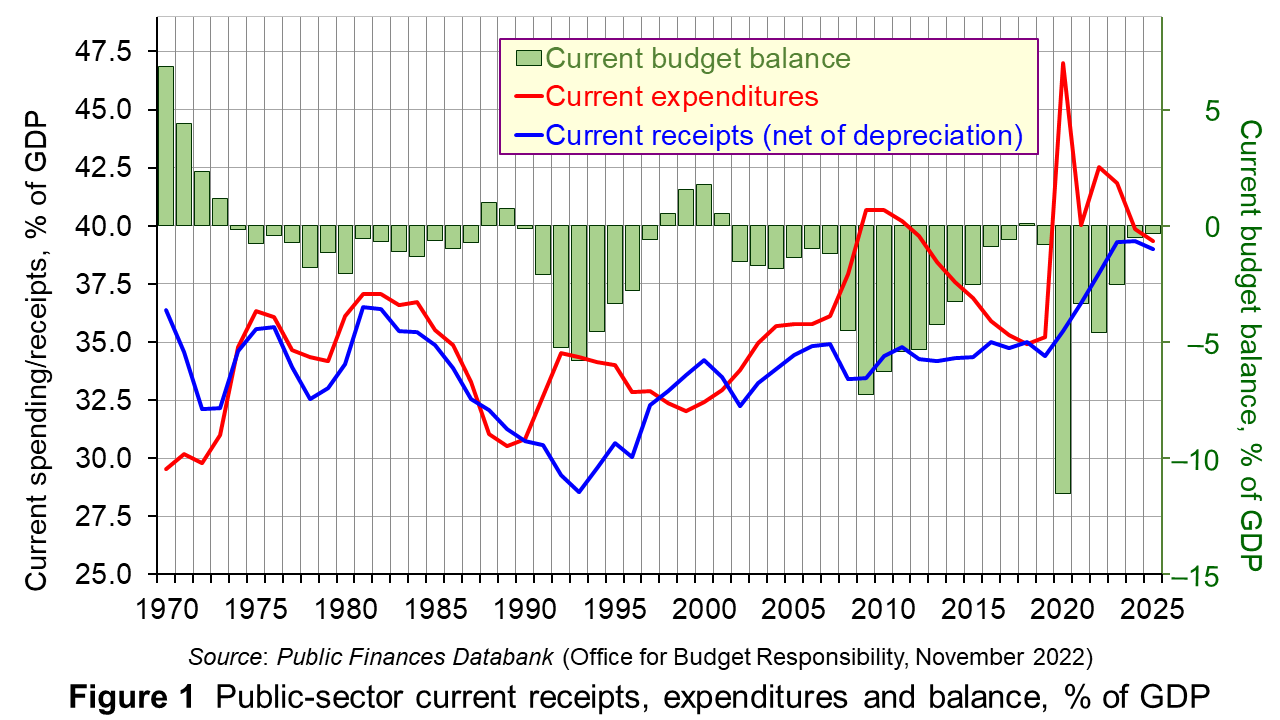 Figure 1 shows public-sector current expenditure and receipts and the balance between them, giving the current deficit (or surplus), shown by the green bars. Current expenditure excludes capital expenditure on things such as hospitals, schools and roads. Since 1973, there has been a current deficit in most years. However, the deficit of 11.5% of GDP in 2020/21 was exceptional given government support measures for households and business during the pandemic. The deficit fell to 3.3% in 2021/22, but is forecast to grow to 4.6% in 2022/23 thanks to government subsidies to energy suppliers to allow energy prices to be capped. (Click here for a PowerPoint of this chart.)
Figure 1 shows public-sector current expenditure and receipts and the balance between them, giving the current deficit (or surplus), shown by the green bars. Current expenditure excludes capital expenditure on things such as hospitals, schools and roads. Since 1973, there has been a current deficit in most years. However, the deficit of 11.5% of GDP in 2020/21 was exceptional given government support measures for households and business during the pandemic. The deficit fell to 3.3% in 2021/22, but is forecast to grow to 4.6% in 2022/23 thanks to government subsidies to energy suppliers to allow energy prices to be capped. (Click here for a PowerPoint of this chart.)
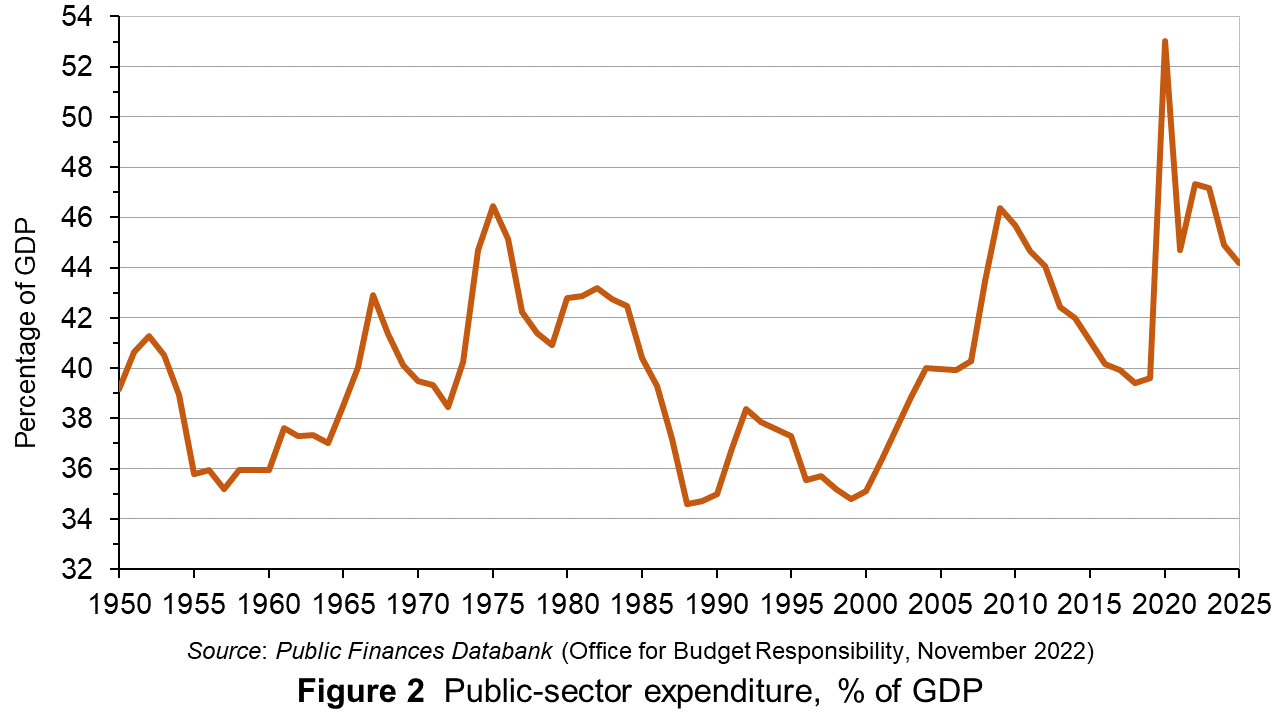 Figure 2 shows public-sector expenditure (current plus capital) from 1950. You can see the spike after the financial crisis of 2007–8 when the government introduced various measures to support the banking system. You can also see the bigger spike in 2020/21 when pandemic support measures saw government expenditure rise to a record 53.0% of GDP. It has risen again this financial year to a predicted to 47.3% of GDP from 44.7% last financial year. It is forecast to fall only slightly, to 47.2%, in 2023/24, before then falling more substantially as the tax rises and spending cuts announced in the Autumn Statement start to take effect. (Click here for a PowerPoint of this chart.)
Figure 2 shows public-sector expenditure (current plus capital) from 1950. You can see the spike after the financial crisis of 2007–8 when the government introduced various measures to support the banking system. You can also see the bigger spike in 2020/21 when pandemic support measures saw government expenditure rise to a record 53.0% of GDP. It has risen again this financial year to a predicted to 47.3% of GDP from 44.7% last financial year. It is forecast to fall only slightly, to 47.2%, in 2023/24, before then falling more substantially as the tax rises and spending cuts announced in the Autumn Statement start to take effect. (Click here for a PowerPoint of this chart.)
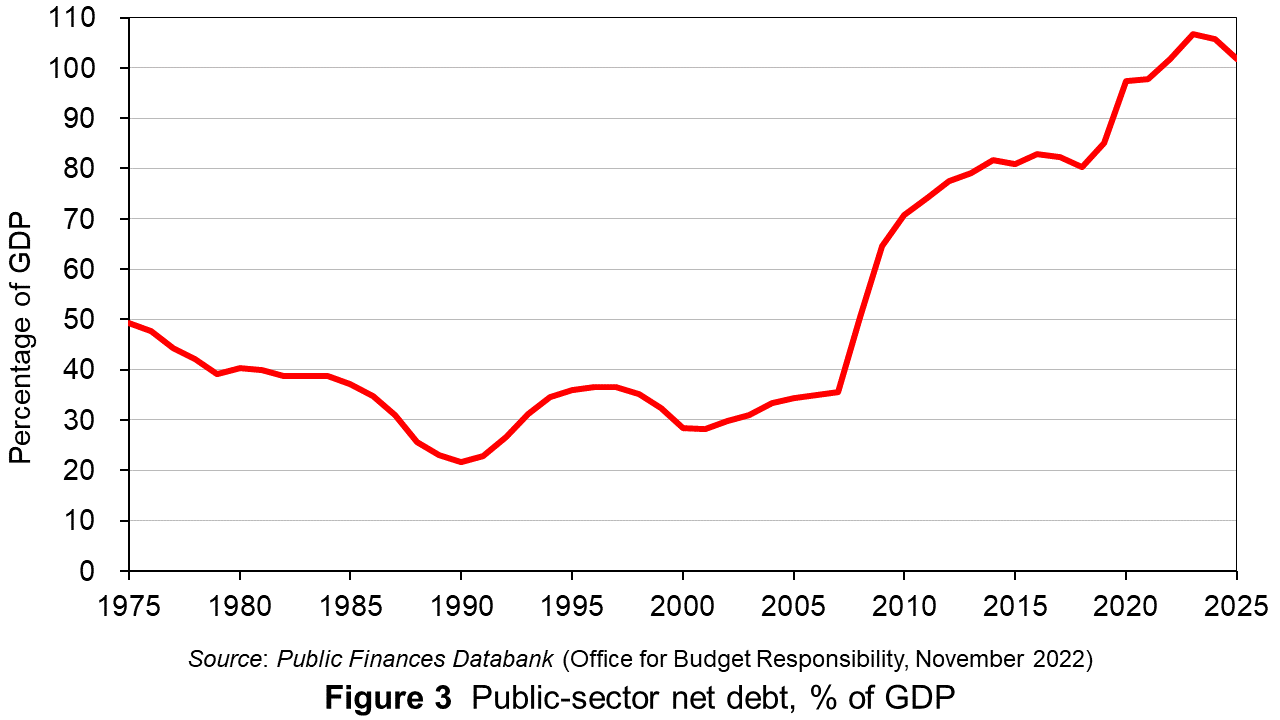 Figure 3 shows public-sector debt since 1975. COVID support measures, capping energy prices and a slow growing or falling GDP have contributed to a rise in debt as a proportion of GDP since 2020/21. Debt is forecast to peak in 2023/24 at a record 106.7% of GDP. During the 20 years from 1988/89 to 2007/8 it averaged just 30.9% of GDP. After the financial crisis of 2007–8 it rose to 81.6% by 2014/15 and then averaged 82.2% between 2014/15 and 2019/20. (Click here for a PowerPoint of this chart.)
Figure 3 shows public-sector debt since 1975. COVID support measures, capping energy prices and a slow growing or falling GDP have contributed to a rise in debt as a proportion of GDP since 2020/21. Debt is forecast to peak in 2023/24 at a record 106.7% of GDP. During the 20 years from 1988/89 to 2007/8 it averaged just 30.9% of GDP. After the financial crisis of 2007–8 it rose to 81.6% by 2014/15 and then averaged 82.2% between 2014/15 and 2019/20. (Click here for a PowerPoint of this chart.)
Criticism
The government has been keen to stress that Mr Hunt’s statement does not amount to a return to the austerity policies of the Conservative-Liberal Democrat coalition government, in office between 2010 and 2015. However, Labour Shadow Chancellor, Rachel Reeves, said Mr Hunt’s Autumn Statement was an ‘invoice for the economic carnage’ the Conservative government had created. There have also been some comments raised by economists questioning the need for spending cuts and tax rises on this scale, with some saying that the decisions being made are political.
 Paul Johnson, the director of the Institute for Fiscal Studies has commented on the plans, stating that the British people ‘just got a lot poorer’ after a series of ‘economic own goals’ that have made a recovery much harder than it might have been. He went on to say that the government was ‘reaping the costs of a long-term failure to grow the economy’, along with an ageing population and high levels of historic borrowing.
Paul Johnson, the director of the Institute for Fiscal Studies has commented on the plans, stating that the British people ‘just got a lot poorer’ after a series of ‘economic own goals’ that have made a recovery much harder than it might have been. He went on to say that the government was ‘reaping the costs of a long-term failure to grow the economy’, along with an ageing population and high levels of historic borrowing.
Disapproval also came from Conservative MP, Jacob Rees-Mogg, who criticised the government’s tax increases. He raised concerns about the government’s plans to increase taxation when the economy is entering a recession. He said, ’You would normally expect there to be some fiscal support for an economy in recession.’
Economic Outlook
High inflation and rising interest rates will lead to consumers spending less, tipping the UK’s economy into a recession, which the OBR expects to last for just over a year. Its forecasts show that the economy will grow by 4.2% this year but will shrink by 1.4% in 2023, before growth slowly picks up again. GDP should then rise by 1.3% in 2024, 2.6% in 2025 and 2.7% in 2026.
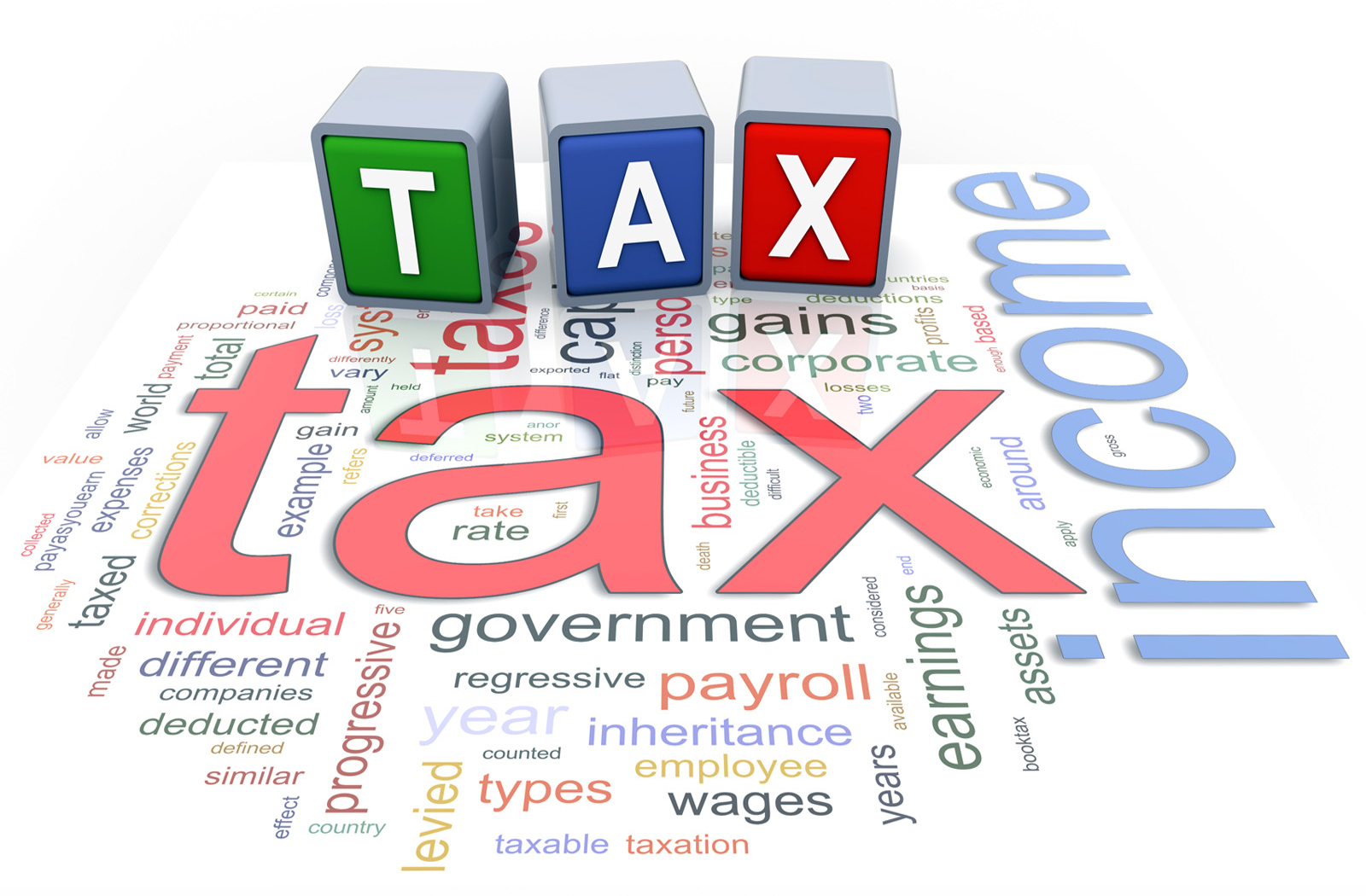 The OBR predicts that there will be 3.2 million more people paying income tax between 2021/22 and 2027/28 as a result of the new tax policy and many more paying higher taxes as a proportion of their income. This is because they will be dragged into higher tax bands as thresholds and allowances on income tax, national insurance and inheritance tax have been frozen until 2028. Government documents said these decisions on personal taxes would raise an additional £3.5bn by 2028 – the consequence of ‘fiscal drag’ pulling more Britons into higher tax brackets. The OBR expects that there will be an extra 2.6 million paying tax at the higher, 40% rate. This is going to put more pressure on households who are already feeling the impact of inflation on their disposable income.
The OBR predicts that there will be 3.2 million more people paying income tax between 2021/22 and 2027/28 as a result of the new tax policy and many more paying higher taxes as a proportion of their income. This is because they will be dragged into higher tax bands as thresholds and allowances on income tax, national insurance and inheritance tax have been frozen until 2028. Government documents said these decisions on personal taxes would raise an additional £3.5bn by 2028 – the consequence of ‘fiscal drag’ pulling more Britons into higher tax brackets. The OBR expects that there will be an extra 2.6 million paying tax at the higher, 40% rate. This is going to put more pressure on households who are already feeling the impact of inflation on their disposable income.
However, this pressure on incomes is set to continue, with real incomes falling by the largest amount since records began in 1956. Real household incomes are forecast to fall by 7% in the next few years, which even after the support from the government, is the equivalent of £1700 per year on average. And the number unemployed is expected to rise by more than 500 000. Senior research economist at the IFS, Xiaowei Xu, described the UK as heading for another lost decade of income growth.
There may be some good news for inflation, with suggestions that it has now peaked. The OBR forecasts that the inflation rate will drop to 7.4% next year. This is still a concern, however, given that the target set for inflation is 2%. Despite the inflation rate potentially peaking, the impact on households has not. The fall in the inflation rate does not mean that prices in the shops will be going down. It just means that they will be going up more slowly than now. The OBR expects that prices will not start to fall (inflation becoming negative) until late 2024.
Conclusion
The overall tone of the government’s announcements was no surprise and policies were largely expected by the markets, hence their muted response. However, this did not make them any less economically painful. There are major concerns for households over what they now face over the next few years, something that the government has not denied.
It has been suggested that this situation, however, has been made worse by historic choices, including cutting state capital spending, cuts in the budget for vocational education, Brexit and Kwasi Kwarteng’s mini-Budget. It is evident that Britons have a tough time ahead in the next year or so. The UK has already had one lost decade of flatlining living standards since the global financial crisis and is now heading for another one with the cost of living crisis.
Articles
- Autumn Statement 2022: Key points at-a-glance
BBC News (17/11/22)
- Autumn statement 2022: key points at a glance
The Guardian, Richard Partington and Aubrey Allegretti (17/11/22)
 Next two years will be ‘challenging’, says Chancellor Jeremy Hunt – as disposable incomes head for biggest fall on record
Next two years will be ‘challenging’, says Chancellor Jeremy Hunt – as disposable incomes head for biggest fall on recordSky News, Sophie Morris (18/11/22)
- What the Autumn Statement means for you and the cost of living
BBC News, Kevin Peachey (17/11/22)
- Autumn Statement: Jeremy Hunt warns of challenges as living standards plunge
BBC News, Kate Whannel (17/11/22)
- Autumn Statement: BBC experts on six things you need to know
BBC News (17/11/22)
- Autumn statement 2022: experts react
The Conversation (17/11/22)
- Autumn Statement Special: Top of the Charts
Resolution Foundation, Torsten Bell (18/11/22)
- Jeremy Hunt’s autumn statement is a poisoned chalice for whoever wins the next election
The Conversation, Steve Schifferes (18/11/22)
- UK households face largest fall in living standards in six decades
Financial Times, Delphine Strauss (17/11/22)
- How the autumn statement brought back the ‘squeezed middle’
The Guardian, Larry Elliott (18/11/22)
- The British people ‘just got a lot poorer’, says IFS thinktank
The Guardian, Anna Isaac (18/11/22)
- Autumn Statement: Hunt has picked pockets of entire country, Labour says
BBC News, Joshua Nevett (17/11/22)
- UK government announces budget; country faces largest fall in living standards since records began
CNBC, Elliot Smith (17/11/22)
- The first step to Britain’s economic recovery is to start telling the truth
The Observer, Will Hutton (20/11/22)
Videos
Analysis
- Autumn Statement 2022 response
Institute for Fiscal Studies, Stuart Adam, Carl Emmerson, Paul Johnson, Robert Joyce, Heidi Karjalainen, Peter Levell, Isabel Stockton, Tom Waters, Thomas Wernham, Xiaowei Xu and Ben Zaranko (17/11/22)
- Help today, squeeze tomorrow: Putting the 2022 Autumn Statement in context
Resolution Foundation, Torsten Bell, Mike Brewer, Molly Broome, Nye Cominetti, Adam Corlett, Emily Fry, Sophie Hale, Karl Handscomb, Jack Leslie, Jonathan Marshall, Charlie McCurdy, Krishan Shah, James Smith,
Gregory Thwaites & Lalitha Try (18/11/22)
Government documentation
Data
Questions
- What do you understand by the term ‘fiscal drag’?
- Provide a critique of the Autumn Statement from the left.
- Provide a critique of the Autumn Statement from the right.
- What are the concerns about raising taxation during a recession?
- Define the term ‘windfall tax’. What are the advantages and disadvantages of imposing/increasing windfall taxes on energy producers in the current situation?
On 3 November, the Bank of England announced the highest interest rate rise in 33 years. It warned that the UK is facing the longest recession since records began. With the downturn starting earlier than expected and predicted to last for longer, households, businesses and the government are braced for a challenging few years ahead.
Interest rates
 The Monetary Policy Committee increased Bank Rate to 3% from the previous rate of 2.25%. This 75-basis point increase is the largest since 1989 and is the eighth rise since December. What is more, the Bank has warned that it will not stop there. These increases in interest rates are there to try to tackle inflation, which rose to 10.1% in September and is expected to be 11% for the final quarter of this year. Soaring prices are a growing concern for UK households, with the cost of living rising at the fastest rate for 40 years. It is feared that such increases in the Bank’s base rate will only worsen household circumstances.
The Monetary Policy Committee increased Bank Rate to 3% from the previous rate of 2.25%. This 75-basis point increase is the largest since 1989 and is the eighth rise since December. What is more, the Bank has warned that it will not stop there. These increases in interest rates are there to try to tackle inflation, which rose to 10.1% in September and is expected to be 11% for the final quarter of this year. Soaring prices are a growing concern for UK households, with the cost of living rising at the fastest rate for 40 years. It is feared that such increases in the Bank’s base rate will only worsen household circumstances.
There are various causes of the current cost-of-living crisis. These include the pandemic’s effect on production, the aftermath in terms of supply-chain problems and labour shortages, the war in Ukraine and its effect on energy and food prices, and poor harvests in many parts of the world, including many European countries. It has been reported that grocery prices in October were 4.7% higher than in October 2021. This is the highest rate of food price inflation on record and means shoppers could face paying an extra £682 per year on average.
There is real concern about the impact of the interest rates rise on the overall economy but, in particular, on peoples’ mortgages. Bank of England Governor, Andrew Bailey, warned of a ‘tough road ahead’ for UK households, but said that the MPC had to act forcefully now or things ‘will be worse later on’.
However, it could be argued that there was a silver lining in Thursday’s announcement. The future rises in interest rates are predicted to peak at a lower rate than previously thought. Amongst all the mini-budget chaos, there was concern that rates could surpass the 6% mark. Now the Bank of England has given the assurance that future rate rises will be limited and that Bank Rate should not increase beyond 5% by next autumn. The Bank was keen to reassure markets of this by making clear the thinking behind the decision in the published minutes of MPC meeting.
Recession
 With the Bank warning of the longest recession since records began, what does this actually mean? Economies experience periods of growth and periods of slowdown or even decline in real GDP. However, a recession is defined as when a country’s economy shrinks for two three-month periods (quarters) in a row. The last time the UK experienced a recession was in 2020 during the height of the pandemic. During a recession, businesses typically make less profits, pay falls, some people may lose their jobs and unemployment rises. This means that the government receives less money in taxation to use on public services such as health and education. Graduates and school leavers could find it harder to get their first job, while others may find it harder to be promoted or to get big enough pay rises to keep pace with price increases. However, the pain of a recession is typically not felt equally across society, and inequality can increase.
With the Bank warning of the longest recession since records began, what does this actually mean? Economies experience periods of growth and periods of slowdown or even decline in real GDP. However, a recession is defined as when a country’s economy shrinks for two three-month periods (quarters) in a row. The last time the UK experienced a recession was in 2020 during the height of the pandemic. During a recession, businesses typically make less profits, pay falls, some people may lose their jobs and unemployment rises. This means that the government receives less money in taxation to use on public services such as health and education. Graduates and school leavers could find it harder to get their first job, while others may find it harder to be promoted or to get big enough pay rises to keep pace with price increases. However, the pain of a recession is typically not felt equally across society, and inequality can increase.
The Bank had previously expected the UK to fall into recession at the end of this year but the latest data from the Office for National Statistics (ONS) show that GDP fell by 0.3% in the three months to August. The Bank is predicting that GDP will shrink by 0.5% between May and August 2023, followed by a further fall of 0.3% between September and December. The Bank then expects the UK economy to remain in recession throughout 2023 and the first half of 2024.
With the higher interest rates, borrowing costs are now at their highest since 2008, when the UK banking system faced collapse in the wake of the global financial crisis. The Bank believes that by raising interest rates it will make it more expensive to borrow and encourage people not to spend money, easing the pressure on prices in the process. It does, however, mean that savers will start to benefit from higher rates (but still negative real rates), but it will have a knock-on effect on those with mortgages, credit card debt and bank loans.
The recession in 2020 only lasted for six months, although the 20.4% reduction in the UK economy between April and June that year was the largest on record. The one before that started in 2008 with the global financial crisis and went on for five quarters. Whilst it will not be the UK’s deepest downturn, the Bank stressed that it will be the longest since records began in the 1920s.
Mortgages
 Those with mortgages are rightly feeling nervous about the impact that further increases in mortgage interest rates will have on their budgets. Variable mortgage rates and new fixed rates have been rising for several months because of this year’s run of rate rises but they shot up after the mini-Budget. The Bank forecasts that if interest rates continue to rise, those whose fixed rate deals are coming to an end could see their annual payments soar by an average of £3000.
Those with mortgages are rightly feeling nervous about the impact that further increases in mortgage interest rates will have on their budgets. Variable mortgage rates and new fixed rates have been rising for several months because of this year’s run of rate rises but they shot up after the mini-Budget. The Bank forecasts that if interest rates continue to rise, those whose fixed rate deals are coming to an end could see their annual payments soar by an average of £3000.
Homebuyers with tracker or variable rate mortgages will feel the pain of the rate rise immediately, while the estimated 300 000 people who must re-mortgage this month will find that two-year and five-year fixed rates remain at levels not seen since the 2008 financial crisis. However, the Bank said that the cost of fixed-rate mortgages had already come down from the levels seen at the height of the panic in the wake of Kwasi Kwarteng’s mini-Budget, which sent them soaring above 6%.
There is a fear of the devastating impact on those who simply cannot afford further increases in payments. The Joseph Rowntree Foundation (JRF) said an extra 120 000 households in the UK, the equivalent of 400 000 people, will be plunged into poverty when their current mortgage deal ends. The analysis assumes that mortgage rates remain high, with homeowners forced to move to an interest rate of around 5.5%. For people currently on fixed rates typically of around of 2% which are due to expire, this change would mean a huge increase. Such people, on average, would find the proportion of their monthly income going on housing costs rising from 38% to 54%. In cash terms this equates to an average increase of £250, from £610 a month to £860 a month.
In addition to these higher monthly home-loan costs threatening to pull another 400 000 people into poverty, such turmoil in the mortgage market would increase competition for rental properties and could result in rents for new lets rising sharply as the extra demand allows buy-to-let landlords to pass on their higher loan costs (or more).
Unemployment
Since the mini-Budget, the level of the pound and government borrowing costs have somewhat recovered. However, mortgage markets and business loans are still showing signs of stress, adding to the prolonged hit to the economy. The Bank now forecasts that the unemployment rate will rise, while household incomes will come down too. The unemployment rate is currently at its lowest for 50 years, but it is expected to rise to nearly 6.5%.
Looking to the future
 It is the case that the lasting effects of the pandemic, the war in Ukraine and the energy shock have all played their part in the current economic climate. However, it could be argued that the Bank and the government are now making decisions that will inflict further pain and sacrifice for millions of households, who are already facing multi-thousand-pound increases in mortgage, energy and food bills.
It is the case that the lasting effects of the pandemic, the war in Ukraine and the energy shock have all played their part in the current economic climate. However, it could be argued that the Bank and the government are now making decisions that will inflict further pain and sacrifice for millions of households, who are already facing multi-thousand-pound increases in mortgage, energy and food bills.
There have been further concerns raised about the possible tax rises planned by the Chancellor Jeremy Hunt. If large tax rises and spending cuts are set out in the Autumn Statement of 17 November, the Bank of England’s chief economist has warned that Britain risks a deeper than expected economic slowdown. This could weigh on the British economy by more than the central bank currently anticipates, in a development that would force it to rethink its approach to setting interest rates.
There is no doubt that the future economic picture looks painful, with the UK performing worse than the USA and the eurozone. The Bank Governor, Andrew Bailey, believes that the mini-Budget had damaged the UK’s reputation internationally, stating, ‘it was very apparent to me that the UK’s position and the UK’s standing had been damaged’. However, both the Governor and the Chancellor or the Exchequer agree that action needs to be taken now in order for the economy to stabilise long term.
Jeremey Hunt, the Chancellor, explained that the most important thing the British government can do right now is to restore stability, sort out the public finances and get debt falling so that interest rate rises are kept as low as possible. This echoes the Bank’s belief in the importance of acting forcefully now in order to prevent things being much worse later on. With the recession predicted to last into 2024, the same year as a possible general election, the Conservatives face campaigning to remain in government at the tail end of a prolonged slump.
Report
Articles
- Bank of England expects UK to fall into longest ever recession
BBC News, Dearbail Jordan & Daniel Thomas (4/11/22)
- What is a recession and how could it affect me?
BBC News (3/11/22)
- Is it right to raise interest rates in a recession?
BBC News, Faisal Islam (4/11/22)
- Rising interest rates: why the Bank of England has increased rates again and what to expect next
The Conversation, Francesc Rodriguez-Tous (7/11/22)
- Bank of England raises interest rates by 0.75 percentage points
Financial Times, Chris Giles and Delphine Strauss (3/11/22)
- Bank of England raises its benchmark rate by 75 basis points, its biggest hike in 33 years
CNBC, Elliot Smith (3/11/22)
- Interest rate rises to 3% as Bank of England imposes biggest hike for three decades
Sky News, Ed Conway (3/11/22)
 Interest Rates: What’s behind the rise?
Interest Rates: What’s behind the rise?Sky News on YouTube, Paul Kelso (3/11/22)
- Falls in UK mortgage rates predicted as BoE signals dovish outlook
Financial Times, James Pickford and Siddharth Venkataramakrishnan (3/11/22)
- BoE outlines two bleak scenarios for taming inflation
Financial Times, Chris Giles (3/11/22)
- Bank of England warns of longest recession in 100 years as it raises rates to 3%
The Guardian, Larry Elliott and Phillip Inman (3/11/22)
- UK mortgage rate rises ‘will put extra 400,000 people in poverty’
The Guardian, Zoe Wood (4/11/22)
- Large tax rises from Jeremy Hunt ‘could put UK at risk of deeper slowdown’
The Guardian, Richard Partington (7/11/22)
- Bank of England will raise interest rates again, says chief economist
The Guardian, Richard Partington (8/11/22)
Questions
- Define the term ‘recession’ and how is it measured.
- Explain what happens to the key macroeconomic indicators during this period of the business cycle.
- Which policies would governments normally implement to get a economy into the
- expansionary/recovery phase of the business cycle and how do they work?
- What is the issue of raising interest rates during a downturn or recession?
- With unemployment expected to rise, explain what type of unemployment this is. What policies could be introduced to reduce this type of unemployment?

Aggregate demand has been booming as the world bounces back from the pandemic. At the same time, aggregate supply is severely constrained. These supply constraints are making potential national income smaller – at least temporarily. The result is that many countries are heading for recession.
At the same time, supply constraints are causing prices to rise, especially energy and food prices. This cost-push inflation is made worse by the rises in aggregate demand.
The result is ‘stagflation’ – a recession, or stagnation, accompanied by high inflation. In the UK, the latest Bank of England Monetary Policy Report forecast that by the end of 2022, CPI inflation would be 13.1% and that in 2023, real GDP would fall by 1.5%.
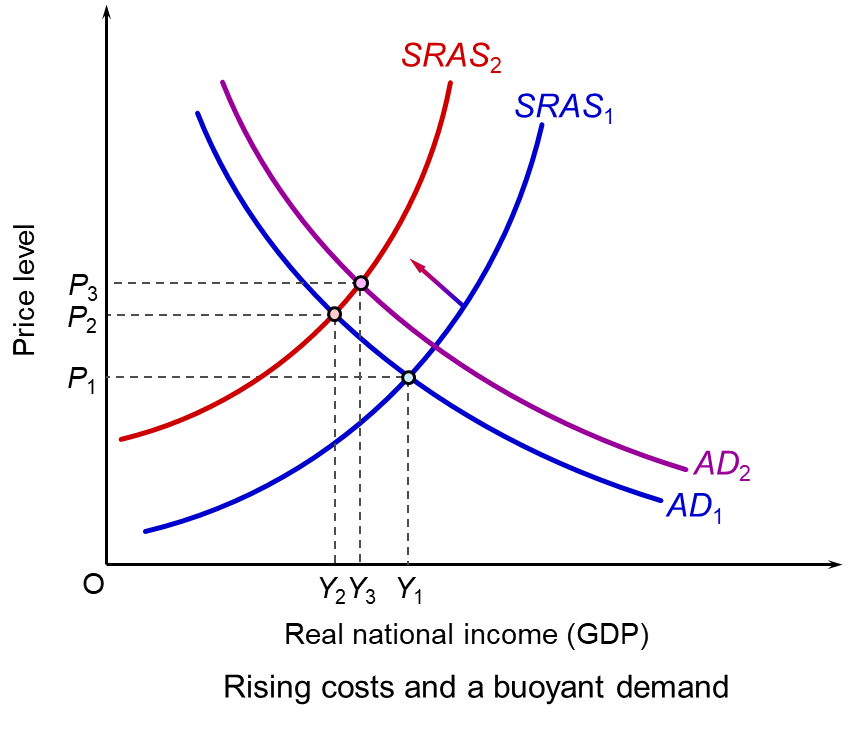 This effect of an adverse supply shock accompanied by relatively buoyant aggregate demand (at least initially) can be illustrated with an aggregate demand and supply diagram. The supply shock is illustrated by an upward shift to the left of the short-run aggregate supply curve (SRAS). (If the shock is a direct rise in prices, then it can be seen as a vertical upward shift. If it is a fall in the total amount supplied, then it can be seen as a horizontal leftward shift.) In the diagram, aggregate supply shifts from SRAS1 to SRAS2. The price level rises from P1 to P2. If costs go on rising or supply goes on falling then the curve will go on shifting upwards to the left.
This effect of an adverse supply shock accompanied by relatively buoyant aggregate demand (at least initially) can be illustrated with an aggregate demand and supply diagram. The supply shock is illustrated by an upward shift to the left of the short-run aggregate supply curve (SRAS). (If the shock is a direct rise in prices, then it can be seen as a vertical upward shift. If it is a fall in the total amount supplied, then it can be seen as a horizontal leftward shift.) In the diagram, aggregate supply shifts from SRAS1 to SRAS2. The price level rises from P1 to P2. If costs go on rising or supply goes on falling then the curve will go on shifting upwards to the left.
If the government responds by increasing benefits or reducing taxes, then, other things being
equal, aggregate demand will rise. In the diagram, the AD curve will shift to the right, e.g. from AD1 to AD2. Real GDP only falls to Y3 not Y2. However, the price level rises further: from P2 to P3.
Why has aggregate supply fallen?
There are several factors that have contributed to the fall in aggregate supply/rise in costs.
- Stretched supply chains, which had been adversely affected by Covid. Congestion at container ports has led to delays, with warehouses and shops being short of stock.
- Labour shortages, with many people not returning to the labour force after being laid off or furloughed, or only returning part time, leaving firms needing more people. The problem has been particularly acute in the UK, with many EU citizens having returned to the EU after Brexit and the UK having to rely increasingly on staff from outside the EU.
 The war in Ukraine. This has had a major impact on the supply of natural gas and oil. The war has also led to a fall in grain and other food supplies from Ukraine, as ports have been blockaded and there have been disruptions to planting and harvesting.
The war in Ukraine. This has had a major impact on the supply of natural gas and oil. The war has also led to a fall in grain and other food supplies from Ukraine, as ports have been blockaded and there have been disruptions to planting and harvesting.- Climate change is causing more severe weather events, such as droughts in Europe and western USA. The droughts of 2022 will compound the problem of food shortages and food price inflation.
- In the UK, Brexit costs, such as increased administrative burdens and difficulties in both exporting and importing, have dampened production and hence adversely impacted on aggregate supply.
- Increased industrial action. As the cost of living soars, unions are demanding pay increases to match the rise in the cost of living. Pay rises further increase firms’ costs – and the bigger the pay rises, the bigger the rise in costs.
The problem with a fall in aggregate supply is that it reduces real GDP. People as a whole are poorer. To use a common analogy, the national ‘pie’ has shrunk. Giving everyone a bigger knife and fork (i.e. a rise in nominal aggregate demand) will not make people better off. It just compounds the problem of rising prices, as the diagram shows.
In the short term, with GDP shrinking, there is a major issue of distribution. If the poor are to be given help so that they are not made even poorer, then other people will have been made worse off. In other words, their nominal incomes must rise more slowly than prices.
Monetary policy
 Central banks generally have a mandate of keeping inflation close to 2% over the medium term. Their levers are changes in interest rates, underpinned by changes in the money supply – in extreme times by quantitative easing (creating money by buying assets with newly created money) or quantitative tightening (withdrawing money from the economy by selling assets). Central banks, faced by soaring inflation, have been raising interest rates. The Fed has recently raised the Federal Funds rate by 0.75 percentage points (75 basis points) and the Bank of England and the European Central Bank by 0.5 percentage points (50 basis points).
Central banks generally have a mandate of keeping inflation close to 2% over the medium term. Their levers are changes in interest rates, underpinned by changes in the money supply – in extreme times by quantitative easing (creating money by buying assets with newly created money) or quantitative tightening (withdrawing money from the economy by selling assets). Central banks, faced by soaring inflation, have been raising interest rates. The Fed has recently raised the Federal Funds rate by 0.75 percentage points (75 basis points) and the Bank of England and the European Central Bank by 0.5 percentage points (50 basis points).
Raising interest rates reduces inflation by dampening aggregate demand. In the diagram, the AD curve shifts to the left (or shifts to the right less quickly). This will dampen inflation, as falling real demand will force firms to cut prices. But it will also force them to cut output and employment, thereby worsening the recession.
Central banks recognise this dilemma, but also recognise that if inflation is not brought rapidly under control, it could spiral upwards, with wages and prices chasing each other in a wage–price spiral, which only gets worse as inflationary expectations rise. The short-term pain of falling real income is a price worth paying for getting inflation under control.
Fiscal policy
In the short term, there is little that fiscal policy can do to raise real GDP. The focus, as it was during the pandemic, must therefore be in providing relief to those most in need.
In the UK, the energy price cap set by Ofgem will see likely energy bills for the typical household quadruple in just a year, from a little over £1000 per annum at January 2021 prices to over £4200 in predicted January 2023 prices. These higher prices partly reflect rising wholesale energy costs and partly the need for energy companies, in a process known as ‘backwardation’, to recoup hedging costs they have incurred so as not to be forced out of business.
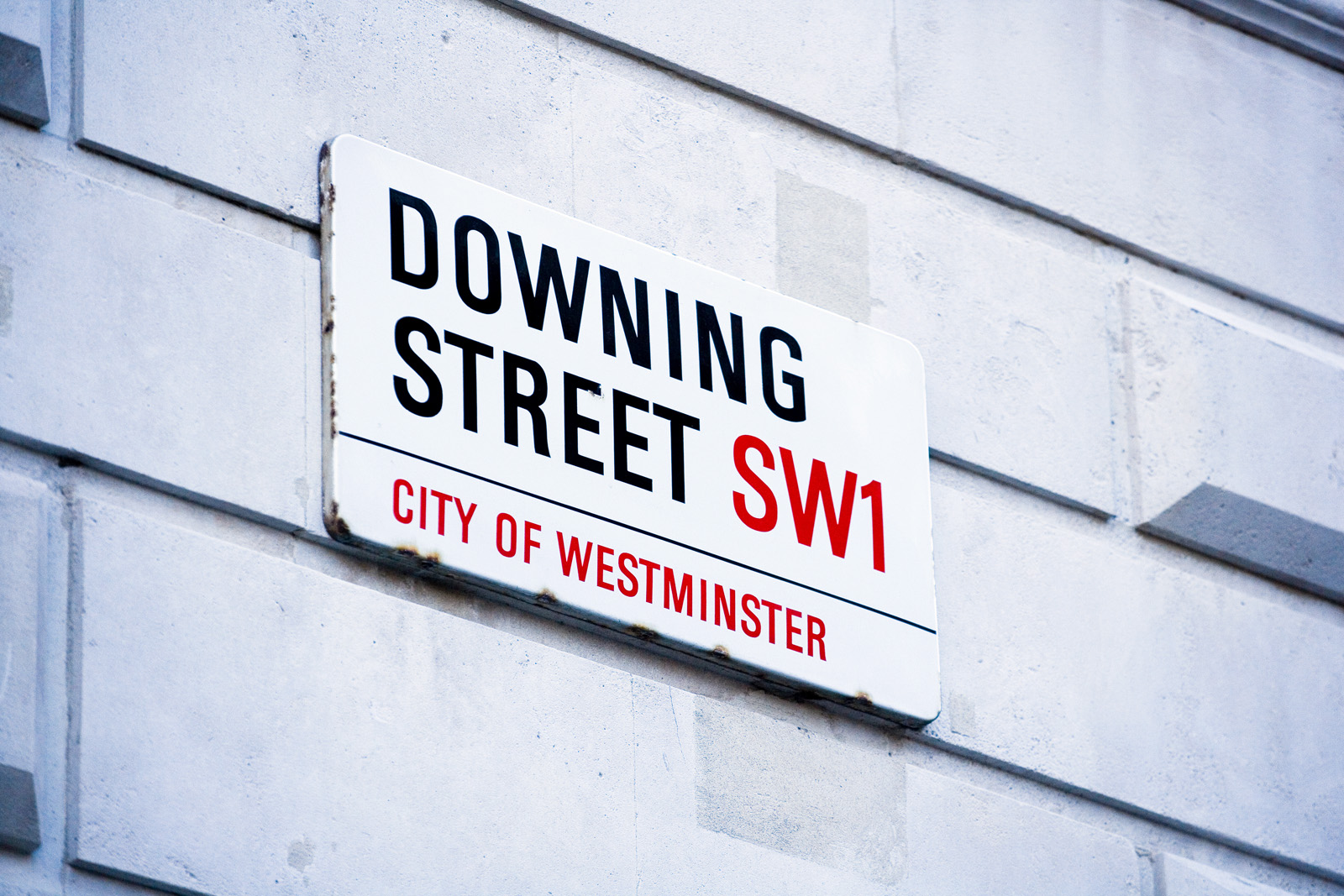 Relief for consumers can be in various forms. For example, the government could pay subsidies to energy suppliers to cap prices at a lower level, perhaps just for the poorest households. Or it could pay grants to help people with their bills. Again, these could be targeted to the poorest families, or paid on a sliding scale according to income. Or VAT on gas and electricity could be scrapped.
Relief for consumers can be in various forms. For example, the government could pay subsidies to energy suppliers to cap prices at a lower level, perhaps just for the poorest households. Or it could pay grants to help people with their bills. Again, these could be targeted to the poorest families, or paid on a sliding scale according to income. Or VAT on gas and electricity could be scrapped.
Generally the more people are entitled to help, the more expensive it is for the government and hence the less generous the help per family is likely to be.
Then there is the question of whether such measures should be accompanied by a rise in broadly-based tax, such as income tax, or whether the government should borrow more, which would be likely to push up interest rates and increase the cost of servicing government debt.
One topic of debate in the Conservative leadership contest is whether taxes should be cut to help people struggling with the cost of living. Whilst such a policy, if carefully targeted to investment, might increase aggregate supply over the longer term, in the short term it will increase aggregate demand and will add to inflationary pressures.
Targeting tax cuts to the poor is difficult. Cutting income tax rates has the opposite effect. The rich pay more income tax than the poor and will benefit most from a cut in rates. An alternative is to raise personal allowances. This will provide a bigger percentage help to income taxpayers on lower incomes, but provides no help at all for the poorest people who currently pay no income tax.
Conclusion
The supply shocks are making countries poorer. The focus in the short term, therefore, needs to be on income distribution and how to help those suffering the most.
To end on a note of optimism: the energy shocks are causing governments to invest in alternative sources, such as wind, solar and nuclear. When these come on line, it is expected that energy prices will fall.
As far as overall inflation is concerned, although the Bank of England is forecasting CPI inflation of 13.1% by Q4 2022, it is also forecasting that this will have fallen to 5.5% by Q4 2023 and to just 0.8% by Q3 2024. Fingers crossed.
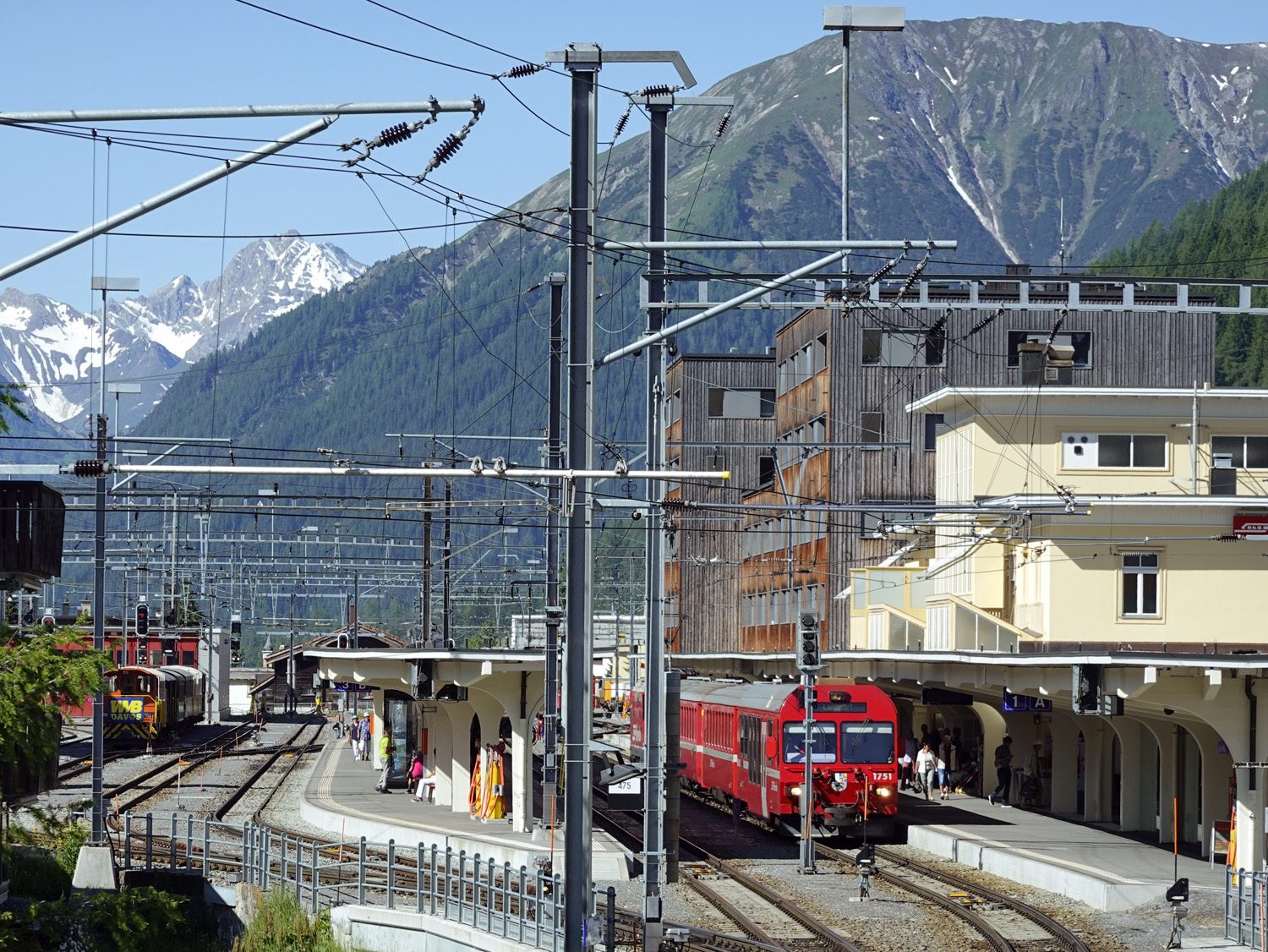 World politicians, business leaders, charities and pressure groups are meeting in Davos at the 2022 World Economic Forum. Normally this event takes place in January each year, but it was postponed to this May because of Covid-19 and is the first face-to-face meeting since January 2020.
World politicians, business leaders, charities and pressure groups are meeting in Davos at the 2022 World Economic Forum. Normally this event takes place in January each year, but it was postponed to this May because of Covid-19 and is the first face-to-face meeting since January 2020.
The meeting takes place amid a series of crises facing the world economy. The IMF’s Managing Director, Kristalina Georgieva, described the current situation as a ‘confluence of calamities’. Problems include:
- Continuing hangovers from Covid have caused economic difficulties in many countries.
- The bounceback from Covid has led to demand outpacing supply. The world is suffering from a range of supply-chain problems and shortages of key materials and components, such as computer chips.
- The war in Ukraine has not only caused suffering in Ukraine itself, but has led to huge energy and food price increases as a result of sanctions and the difficulties in exporting wheat, sunflower oil and other foodstuffs.
- Supply shocks have led to rising global inflation. This will feed into higher inflationary expectations, which will compound the problem if they result in higher prices and wages in response to higher costs.
- Central banks have responded by raising interest rates. These dampen an already weakened global economy and could push the world into recession.
- Global inequality is rising rapidly, both within countries and between countries, as Covid disruptions and higher food and energy prices hit the poor disproportionately. Poor people and countries also have a higher proportion of debt and are thus hit especially hard by higher interest rates.
- Global warming is having increasing effects, with a growing incidence of floods, droughts and hurricanes. These lead to crop failures and the displacement of people.
- Countries are increasingly resorting to trade restrictions as they seek to protect their own economies. These slow economic growth.
World leaders at Davos will be debating what can be done. One approach is to use fiscal policy. Indeed, Kristalina Georgieva said that her ‘main message is to recognise that the world must spend the billions necessary to contain Covid in order to gain trillions in output as a result’. But unless the increased expenditure is aimed specifically at tackling supply shortages and bottlenecks, it could simply add to rising inflation. Increasing aggregate demand in the context of supply shortages is not the solution.
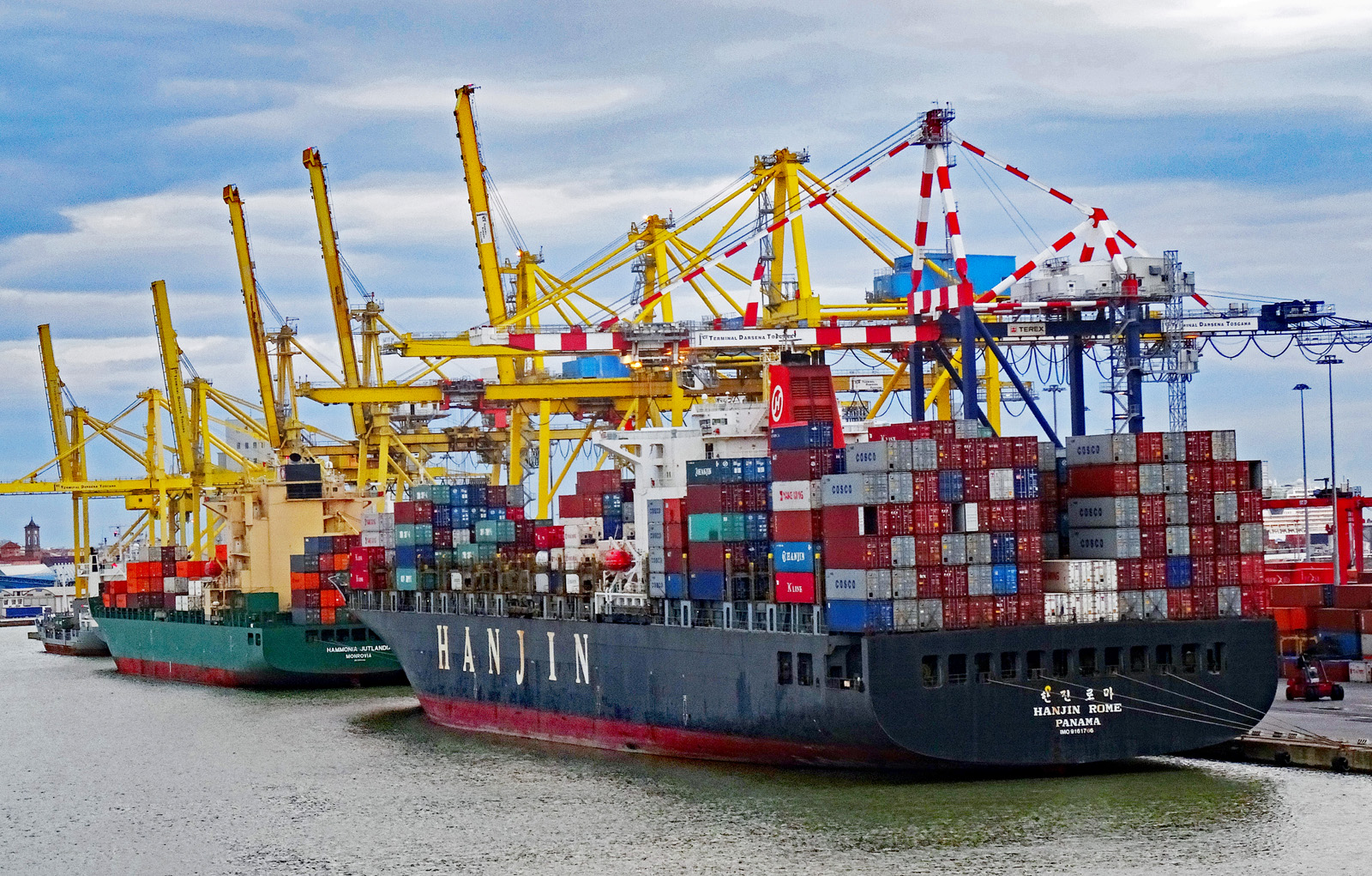 In the long run, supply bottlenecks can be overcome with appropriate investment. This may require both greater globalisation and greater localisation, with investment in supply chains that use both local and international sources.
In the long run, supply bottlenecks can be overcome with appropriate investment. This may require both greater globalisation and greater localisation, with investment in supply chains that use both local and international sources.
International sources can be widened with greater investment in manufacturing in some of the poorer developing countries. This would also help to tackle global inequality. Greater localisation for some inputs, especially heavier or more bulky ones, would help to reduce transport costs and the consumption of fuel.
With severe supply shocks, there are no simple solutions. With less supply, the world produces less and becomes poorer – at least temporarily until supply can increase again.
Articles
Discussion (video)
Report
Questions
- Draw an aggregate demand and supply diagram (AD/AS or DAD/DAS) to illustrate the effect of a supply shock on output and prices.
- Give some examples of supply-side policies that could help in the current situation.
- What are the arguments for and against countries using protectionist policies at the current time?
- What policies could countries adopt to alleviate rapid rises in the cost of living for people on low incomes? What problems do these policies pose?
- What are the arguments for and against imposing a windfall tax on energy companies and using the money to support poor people?
- If the world slips into recession, should central banks and governments use expansionary monetary and fiscal policies?
 The suffering inflicted on the Ukrainian people by the Russian invasion is immense. But, at a much lower level, the war will also inflict costs on people in countries around the world. There will be significant costs to households in the form of even higher energy and food price inflation and a possible economic slowdown. The reactions of governments and central banks could put a further squeeze on living standards. Stock markets could fall further and investment could decline as firms lose confidence.
The suffering inflicted on the Ukrainian people by the Russian invasion is immense. But, at a much lower level, the war will also inflict costs on people in countries around the world. There will be significant costs to households in the form of even higher energy and food price inflation and a possible economic slowdown. The reactions of governments and central banks could put a further squeeze on living standards. Stock markets could fall further and investment could decline as firms lose confidence.
Russia is the world’s second largest oil supplier and any disruption to supplies will drive up the price of oil significantly. Ahead of the invasion, oil prices were rising. At the beginning of February, Brent crude was around $90 per barrel. With the invasion, it rose above $100 per barrel.
 Russia is also a major producer of natural gas. The EU is particularly dependent on Russia, which supplies 40% of its natural gas. With Germany halting approval of the major new gas pipeline under the Baltic from Russia to Germany, Nord Stream 2, the price of gas has rocketed. On the day of the invasion, European gas prices rose by over 50%.
Russia is also a major producer of natural gas. The EU is particularly dependent on Russia, which supplies 40% of its natural gas. With Germany halting approval of the major new gas pipeline under the Baltic from Russia to Germany, Nord Stream 2, the price of gas has rocketed. On the day of the invasion, European gas prices rose by over 50%.
Nevertheless, with the USA deciding not to extend sanctions to Russia’s energy sector, the price of gas fell back by 32% the next day. It remains to be seen just how much the supplies of oil and gas from Russia will be disrupted over the coming weeks.
Both Russia and Ukraine are major suppliers of wheat and maize, between them responsible for 14% of global wheat production and 30% of global wheat exports. A significant rise in the price of wheat and other grains will exacerbate the current rise in food price inflation.
Russia is also a significant supplier of metals, such as copper, platinum, aluminium and nickel, which are used in a wide variety of products. A rise in their price has begun and will further add to inflationary pressures and supply-chain problems which have followed the pandemic.
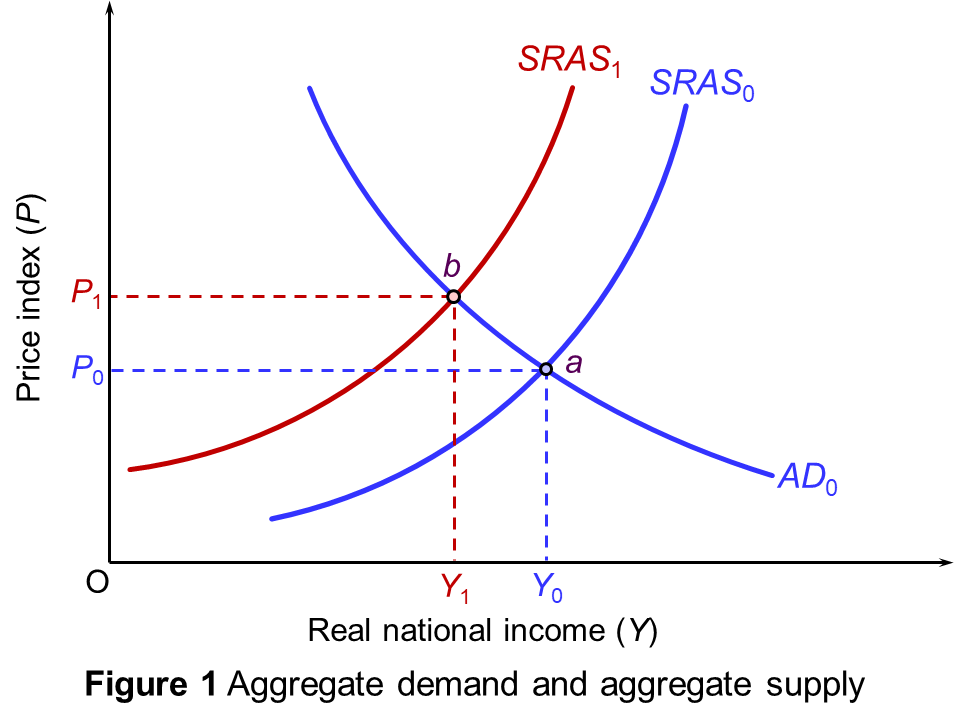 The effect of these supply shocks can be illustrated in a simple aggregate demand and supply diagram (see Figure 1), which shows a representative economy that imports energy, grain and other resources. Aggregate demand and short-run aggregate supply are initially given by AD0 and SRAS0. Equilibrium is at point a, with real national income (real GDP) of Y0 and a price index of P0.
The effect of these supply shocks can be illustrated in a simple aggregate demand and supply diagram (see Figure 1), which shows a representative economy that imports energy, grain and other resources. Aggregate demand and short-run aggregate supply are initially given by AD0 and SRAS0. Equilibrium is at point a, with real national income (real GDP) of Y0 and a price index of P0.
The supply shock shifts short-run aggregate supply to SRAS1. Equilibrium moves to point b. The price index rises to P1 and real national income falls to Y1. If it is a ‘one-off’ cost increase, then the price index will settle at the new higher level and GDP at the new lower level provided that real aggregate demand remains the same. Inflation will be temporary. If, however, the SRAS curve continues to shift upwards to the left, then cost-push inflation will continue.
These supply-side shocks make the resulting inflation hard for policymakers to deal with. When the problem lies on the demand side, where the inflation is accompanied by an unsustainable boom, a contractionary fiscal and monetary policy can stabilise the economy and reduce inflation. But the inflationary problem today is not demand-pull inflation; it’s cost-push inflation. Disruptions to supply are both driving up prices and causing an economic slowdown – a situation of ‘stagflation’, or even an inflationary recession.
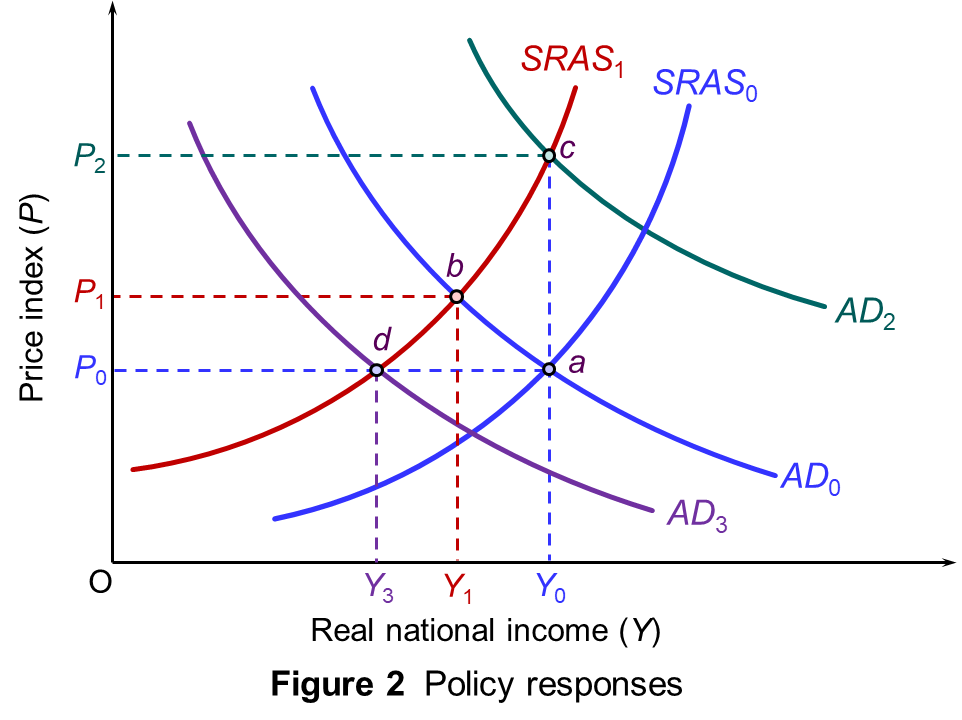 An expansionary policy, such as increasing bond purchases (quantitative easing) or increasing government spending, may help to avoid recession (at least temporarily), but will only exacerbate inflation. In Figure 2, aggregate demand shifts to AD2. Equilibrium moves to point c. Real GDP returns to Y0 (at least temporarily) but the price level rises further, to P2. (Click here for a PowerPoint of the diagram.)
An expansionary policy, such as increasing bond purchases (quantitative easing) or increasing government spending, may help to avoid recession (at least temporarily), but will only exacerbate inflation. In Figure 2, aggregate demand shifts to AD2. Equilibrium moves to point c. Real GDP returns to Y0 (at least temporarily) but the price level rises further, to P2. (Click here for a PowerPoint of the diagram.)
A contractionary policy, such as raising interest rates or taxes, may help to reduce inflation but will make the slowdown worse and could lead to recession. In the diagram, aggregate demand shifts to AD3. Equilibrium moves to point d. The price level returns to P0 (at least temporarily) but real income falls further, to Y3.
In other words, you cannot tackle both the slowdown/recession and the inflation simultaneously by the use of demand-side policy. One requires an expansionary fiscal and/or monetary policy; the other requires fiscal and/or monetary tightening.
Then there are other likely economic stresses. If NATO countries respond by increasing defence expenditure, this will put further strain on public finances.
Sentiment is a key driver of the economy and prices. Expectations tend to be self-fulfilling. So if the war in Ukraine undermines confidence in stock markets and the real economy and further raises inflationary expectations, this pessimistic mood will tend in itself to drive down share prices, drive up inflation and drive down investment and economic growth.
Articles
- How will Russia’s invasion of Ukraine hit the global economy?
Financial Times, Chris Giles, Jonathan Wheatley and Valentina Romei (25/2/22)
- Ukraine conflict raises the possibility of stagflation
Financial Times, The Editorial Board (25/2/22)
- Five ways the Ukraine war could push up prices
BBC News, Laura Jones (5/3/22)
- Jason Furman cautions against reading too much into the initial market reactions to Russia’s invasion
interest.co.nz, Jason Furman (26/2/22)
- Putin’s war promises to crush the global economy with inflation and much slower growth
Market Watch, Nouriel Roubini (25/2/22)
- Roubini: 6 Financial, Economic Risks of Russia-Ukraine War
ThinkAdvisor, Janet Levaux (25/2/22)
- Fed tightening plans now contending with war, possible oil shock
Reuters, Howard Schneider and Jonnelle Marte (24/2/22)
- The invasion of Ukraine changed everything for Wall Street
CNN, Julia Horowitz (27/2/22)
- Why the Russian invasion will have huge economic consequences for American families
CNN, Matt Egan (24/2/22)
- European gas prices soar and oil tops $105 after Russia attacks Ukraine
Financial Times, Neil Hume, Emiko Terazono and Tom Wilson (24/2/22)
- Five essential commodities that will be hit by war in Ukraine
The Conversation, Sarah Schiffling and Nikolaos Valantasis Kanellos (24/2/22)
- Ukraine: ‘I’m surprised the oil price hasn’t hit US$130 a barrel yet’ – energy trading expert Q&A
The Conversation, Adi Imsirovic (25/2/22)
- Ukraine crisis: Warning UK energy bills could top £3,000 a year
BBC News, Michael Race (25/2/22)
- Putin’s energy shock: The economic realities of invasion
BBC News, Faisal Islam (25/2/22)
- Fears of UK food and fuel prices rising due to war
BBC News, Oliver Smith & Michael Race (26/2/22)
- Ukraine conflict: What is Swift and why is banning Russia so significant?
BBC News, Russell Hotten (27/2/22)
- Ukraine conflict: How reliant is Europe on Russia for oil and gas?
BBC News, Jake Horton & Daniele Palumbo (25/2/22)
- Ukraine crisis complicates ECB’s path to higher rates
Reuters, Francesco Canepa and Balazs Koranyi (24/2/22)
- Russia and the West are moving towards all out economic war
Al Jazeera, Maximilian Hess (24/2/22)
Questions
- If there is a negative supply shock, what will determine the size of the resulting increase in the price level and the rate of inflation over the next one or two years?
- How may expectations affect (a) the size of the increase in the price level; (b) future prices of gas and oil?
- Why did stock markets rise on the day after the invasion of Ukraine?
- Argue the case for and against relaxing monetary policy and delaying tax rises in the light of the economic consequences of the war in Ukraine.
 The Autumn Statement was announced by Jeremy Hunt in Parliament on Thursday 17th November. This was Hunt’s first big speech since becoming Chancellor or the Exchequer a few weeks ago. He revealed to the House of Commons that there will be tax rises and spending cuts worth billions of pounds, aimed at mending the nation’s finances. It is hoped that the new plans will restore market confidence shaken by his predecessor’s mini-Budget. He claimed that the mixture of tax rises and spending cuts would be distributed fairly.
The Autumn Statement was announced by Jeremy Hunt in Parliament on Thursday 17th November. This was Hunt’s first big speech since becoming Chancellor or the Exchequer a few weeks ago. He revealed to the House of Commons that there will be tax rises and spending cuts worth billions of pounds, aimed at mending the nation’s finances. It is hoped that the new plans will restore market confidence shaken by his predecessor’s mini-Budget. He claimed that the mixture of tax rises and spending cuts would be distributed fairly. It was expected that the Statement was not going to be one to celebrate, given that the UK is now believed to be in a recession. The Office for Budget Responsibility (OBR) forecasts that the UK economy will shrink by 1.4% next year. However, Hunt said that his focus was on stability and ensuring a shallower downturn. The Chancellor outlined his ‘plan for stability’ by announcing deep spending cuts and tax rises in the autumn statement. He said that half of his £55bn plan would come from tax rises, and the rest from spending cuts.
It was expected that the Statement was not going to be one to celebrate, given that the UK is now believed to be in a recession. The Office for Budget Responsibility (OBR) forecasts that the UK economy will shrink by 1.4% next year. However, Hunt said that his focus was on stability and ensuring a shallower downturn. The Chancellor outlined his ‘plan for stability’ by announcing deep spending cuts and tax rises in the autumn statement. He said that half of his £55bn plan would come from tax rises, and the rest from spending cuts.  Figure 1 shows public-sector current expenditure and receipts and the balance between them, giving the current deficit (or surplus), shown by the green bars. Current expenditure excludes capital expenditure on things such as hospitals, schools and roads. Since 1973, there has been a current deficit in most years. However, the deficit of 11.5% of GDP in 2020/21 was exceptional given government support measures for households and business during the pandemic. The deficit fell to 3.3% in 2021/22, but is forecast to grow to 4.6% in 2022/23 thanks to government subsidies to energy suppliers to allow energy prices to be capped. (Click here for a PowerPoint of this chart.)
Figure 1 shows public-sector current expenditure and receipts and the balance between them, giving the current deficit (or surplus), shown by the green bars. Current expenditure excludes capital expenditure on things such as hospitals, schools and roads. Since 1973, there has been a current deficit in most years. However, the deficit of 11.5% of GDP in 2020/21 was exceptional given government support measures for households and business during the pandemic. The deficit fell to 3.3% in 2021/22, but is forecast to grow to 4.6% in 2022/23 thanks to government subsidies to energy suppliers to allow energy prices to be capped. (Click here for a PowerPoint of this chart.) Figure 2 shows public-sector expenditure (current plus capital) from 1950. You can see the spike after the financial crisis of 2007–8 when the government introduced various measures to support the banking system. You can also see the bigger spike in 2020/21 when pandemic support measures saw government expenditure rise to a record 53.0% of GDP. It has risen again this financial year to a predicted to 47.3% of GDP from 44.7% last financial year. It is forecast to fall only slightly, to 47.2%, in 2023/24, before then falling more substantially as the tax rises and spending cuts announced in the Autumn Statement start to take effect. (Click here for a PowerPoint of this chart.)
Figure 2 shows public-sector expenditure (current plus capital) from 1950. You can see the spike after the financial crisis of 2007–8 when the government introduced various measures to support the banking system. You can also see the bigger spike in 2020/21 when pandemic support measures saw government expenditure rise to a record 53.0% of GDP. It has risen again this financial year to a predicted to 47.3% of GDP from 44.7% last financial year. It is forecast to fall only slightly, to 47.2%, in 2023/24, before then falling more substantially as the tax rises and spending cuts announced in the Autumn Statement start to take effect. (Click here for a PowerPoint of this chart.) Figure 3 shows public-sector debt since 1975. COVID support measures, capping energy prices and a slow growing or falling GDP have contributed to a rise in debt as a proportion of GDP since 2020/21. Debt is forecast to peak in 2023/24 at a record 106.7% of GDP. During the 20 years from 1988/89 to 2007/8 it averaged just 30.9% of GDP. After the financial crisis of 2007–8 it rose to 81.6% by 2014/15 and then averaged 82.2% between 2014/15 and 2019/20. (Click here for a PowerPoint of this chart.)
Figure 3 shows public-sector debt since 1975. COVID support measures, capping energy prices and a slow growing or falling GDP have contributed to a rise in debt as a proportion of GDP since 2020/21. Debt is forecast to peak in 2023/24 at a record 106.7% of GDP. During the 20 years from 1988/89 to 2007/8 it averaged just 30.9% of GDP. After the financial crisis of 2007–8 it rose to 81.6% by 2014/15 and then averaged 82.2% between 2014/15 and 2019/20. (Click here for a PowerPoint of this chart.) Paul Johnson, the director of the Institute for Fiscal Studies has commented on the plans, stating that the British people ‘just got a lot poorer’ after a series of ‘economic own goals’ that have made a recovery much harder than it might have been. He went on to say that the government was ‘reaping the costs of a long-term failure to grow the economy’, along with an ageing population and high levels of historic borrowing.
Paul Johnson, the director of the Institute for Fiscal Studies has commented on the plans, stating that the British people ‘just got a lot poorer’ after a series of ‘economic own goals’ that have made a recovery much harder than it might have been. He went on to say that the government was ‘reaping the costs of a long-term failure to grow the economy’, along with an ageing population and high levels of historic borrowing. The OBR predicts that there will be 3.2 million more people paying income tax between 2021/22 and 2027/28 as a result of the new tax policy and many more paying higher taxes as a proportion of their income. This is because they will be dragged into higher tax bands as thresholds and allowances on income tax, national insurance and inheritance tax have been frozen until 2028. Government documents said these decisions on personal taxes would raise an additional £3.5bn by 2028 – the consequence of ‘fiscal drag’ pulling more Britons into higher tax brackets. The OBR expects that there will be an extra 2.6 million paying tax at the higher, 40% rate. This is going to put more pressure on households who are already feeling the impact of inflation on their disposable income.
The OBR predicts that there will be 3.2 million more people paying income tax between 2021/22 and 2027/28 as a result of the new tax policy and many more paying higher taxes as a proportion of their income. This is because they will be dragged into higher tax bands as thresholds and allowances on income tax, national insurance and inheritance tax have been frozen until 2028. Government documents said these decisions on personal taxes would raise an additional £3.5bn by 2028 – the consequence of ‘fiscal drag’ pulling more Britons into higher tax brackets. The OBR expects that there will be an extra 2.6 million paying tax at the higher, 40% rate. This is going to put more pressure on households who are already feeling the impact of inflation on their disposable income.  Next two years will be ‘challenging’, says Chancellor Jeremy Hunt – as disposable incomes head for biggest fall on record
Next two years will be ‘challenging’, says Chancellor Jeremy Hunt – as disposable incomes head for biggest fall on record Chancellor of the Exchequer Jeremy Hunt Autumn Statement
Chancellor of the Exchequer Jeremy Hunt Autumn Statement The Autumn Statement 2022 explained
The Autumn Statement 2022 explained Autumn Statement 2022
Autumn Statement 2022 What does the economic forecast mean for the coming years?
What does the economic forecast mean for the coming years? The Monetary Policy Committee increased Bank Rate to 3% from the previous rate of 2.25%. This 75-basis point increase is the largest since 1989 and is the eighth rise since December. What is more, the Bank has warned that it will not stop there. These increases in interest rates are there to try to tackle inflation, which rose to 10.1% in September and is expected to be 11% for the final quarter of this year. Soaring prices are a growing concern for UK households, with the cost of living rising at the fastest rate for 40 years. It is feared that such increases in the Bank’s base rate will only worsen household circumstances.
The Monetary Policy Committee increased Bank Rate to 3% from the previous rate of 2.25%. This 75-basis point increase is the largest since 1989 and is the eighth rise since December. What is more, the Bank has warned that it will not stop there. These increases in interest rates are there to try to tackle inflation, which rose to 10.1% in September and is expected to be 11% for the final quarter of this year. Soaring prices are a growing concern for UK households, with the cost of living rising at the fastest rate for 40 years. It is feared that such increases in the Bank’s base rate will only worsen household circumstances. Those with mortgages are rightly feeling nervous about the impact that further increases in mortgage interest rates will have on their budgets. Variable mortgage rates and new fixed rates have been rising for several months because of this year’s run of rate rises but they shot up after the
Those with mortgages are rightly feeling nervous about the impact that further increases in mortgage interest rates will have on their budgets. Variable mortgage rates and new fixed rates have been rising for several months because of this year’s run of rate rises but they shot up after the  It is the case that the lasting effects of the pandemic, the war in Ukraine and the energy shock have all played their part in the current economic climate. However, it could be argued that the Bank and the government are now making decisions that will inflict further pain and sacrifice for millions of households, who are already facing multi-thousand-pound increases in mortgage, energy and food bills.
It is the case that the lasting effects of the pandemic, the war in Ukraine and the energy shock have all played their part in the current economic climate. However, it could be argued that the Bank and the government are now making decisions that will inflict further pain and sacrifice for millions of households, who are already facing multi-thousand-pound increases in mortgage, energy and food bills.
 This effect of an adverse supply shock accompanied by relatively buoyant aggregate demand (at least initially) can be illustrated with an aggregate demand and supply diagram. The supply shock is illustrated by an upward shift to the left of the short-run aggregate supply curve (SRAS). (If the shock is a direct rise in prices, then it can be seen as a vertical upward shift. If it is a fall in the total amount supplied, then it can be seen as a horizontal leftward shift.) In the diagram, aggregate supply shifts from SRAS1 to SRAS2. The price level rises from P1 to P2. If costs go on rising or supply goes on falling then the curve will go on shifting upwards to the left.
This effect of an adverse supply shock accompanied by relatively buoyant aggregate demand (at least initially) can be illustrated with an aggregate demand and supply diagram. The supply shock is illustrated by an upward shift to the left of the short-run aggregate supply curve (SRAS). (If the shock is a direct rise in prices, then it can be seen as a vertical upward shift. If it is a fall in the total amount supplied, then it can be seen as a horizontal leftward shift.) In the diagram, aggregate supply shifts from SRAS1 to SRAS2. The price level rises from P1 to P2. If costs go on rising or supply goes on falling then the curve will go on shifting upwards to the left. The war in Ukraine. This has had a major impact on the supply of natural gas and oil. The war has also led to a fall in grain and other food supplies from Ukraine, as ports have been blockaded and there have been disruptions to planting and harvesting.
The war in Ukraine. This has had a major impact on the supply of natural gas and oil. The war has also led to a fall in grain and other food supplies from Ukraine, as ports have been blockaded and there have been disruptions to planting and harvesting. Relief for consumers can be in various forms. For example, the government could pay subsidies to energy suppliers to cap prices at a lower level, perhaps just for the poorest households. Or it could pay grants to help people with their bills. Again, these could be targeted to the poorest families, or paid on a sliding scale according to income. Or VAT on gas and electricity could be scrapped.
Relief for consumers can be in various forms. For example, the government could pay subsidies to energy suppliers to cap prices at a lower level, perhaps just for the poorest households. Or it could pay grants to help people with their bills. Again, these could be targeted to the poorest families, or paid on a sliding scale according to income. Or VAT on gas and electricity could be scrapped. World politicians, business leaders, charities and pressure groups are meeting in Davos at the
World politicians, business leaders, charities and pressure groups are meeting in Davos at the  In the long run, supply bottlenecks can be overcome with appropriate investment. This may require both greater globalisation and greater localisation, with investment in supply chains that use both local and international sources.
In the long run, supply bottlenecks can be overcome with appropriate investment. This may require both greater globalisation and greater localisation, with investment in supply chains that use both local and international sources.  The suffering inflicted on the Ukrainian people by the Russian invasion is immense. But, at a much lower level, the war will also inflict costs on people in countries around the world. There will be significant costs to households in the form of even higher energy and food price inflation and a possible economic slowdown. The reactions of governments and central banks could put a further squeeze on living standards. Stock markets could fall further and investment could decline as firms lose confidence.
The suffering inflicted on the Ukrainian people by the Russian invasion is immense. But, at a much lower level, the war will also inflict costs on people in countries around the world. There will be significant costs to households in the form of even higher energy and food price inflation and a possible economic slowdown. The reactions of governments and central banks could put a further squeeze on living standards. Stock markets could fall further and investment could decline as firms lose confidence. Russia is also a major producer of natural gas. The EU is particularly dependent on Russia, which supplies 40% of its natural gas. With Germany halting approval of the major new gas pipeline under the Baltic from Russia to Germany, Nord Stream 2, the price of gas has rocketed. On the day of the invasion, European gas prices rose by over 50%.
Russia is also a major producer of natural gas. The EU is particularly dependent on Russia, which supplies 40% of its natural gas. With Germany halting approval of the major new gas pipeline under the Baltic from Russia to Germany, Nord Stream 2, the price of gas has rocketed. On the day of the invasion, European gas prices rose by over 50%.  The effect of these supply shocks can be illustrated in a simple aggregate demand and supply diagram (see Figure 1), which shows a representative economy that imports energy, grain and other resources. Aggregate demand and short-run aggregate supply are initially given by AD0 and SRAS0. Equilibrium is at point a, with real national income (real GDP) of Y0 and a price index of P0.
The effect of these supply shocks can be illustrated in a simple aggregate demand and supply diagram (see Figure 1), which shows a representative economy that imports energy, grain and other resources. Aggregate demand and short-run aggregate supply are initially given by AD0 and SRAS0. Equilibrium is at point a, with real national income (real GDP) of Y0 and a price index of P0. An expansionary policy, such as increasing bond purchases (quantitative easing) or increasing government spending, may help to avoid recession (at least temporarily), but will only exacerbate inflation. In Figure 2, aggregate demand shifts to AD2. Equilibrium moves to point c. Real GDP returns to Y0 (at least temporarily) but the price level rises further, to P2. (Click
An expansionary policy, such as increasing bond purchases (quantitative easing) or increasing government spending, may help to avoid recession (at least temporarily), but will only exacerbate inflation. In Figure 2, aggregate demand shifts to AD2. Equilibrium moves to point c. Real GDP returns to Y0 (at least temporarily) but the price level rises further, to P2. (Click